Fountain Medal
Play with water

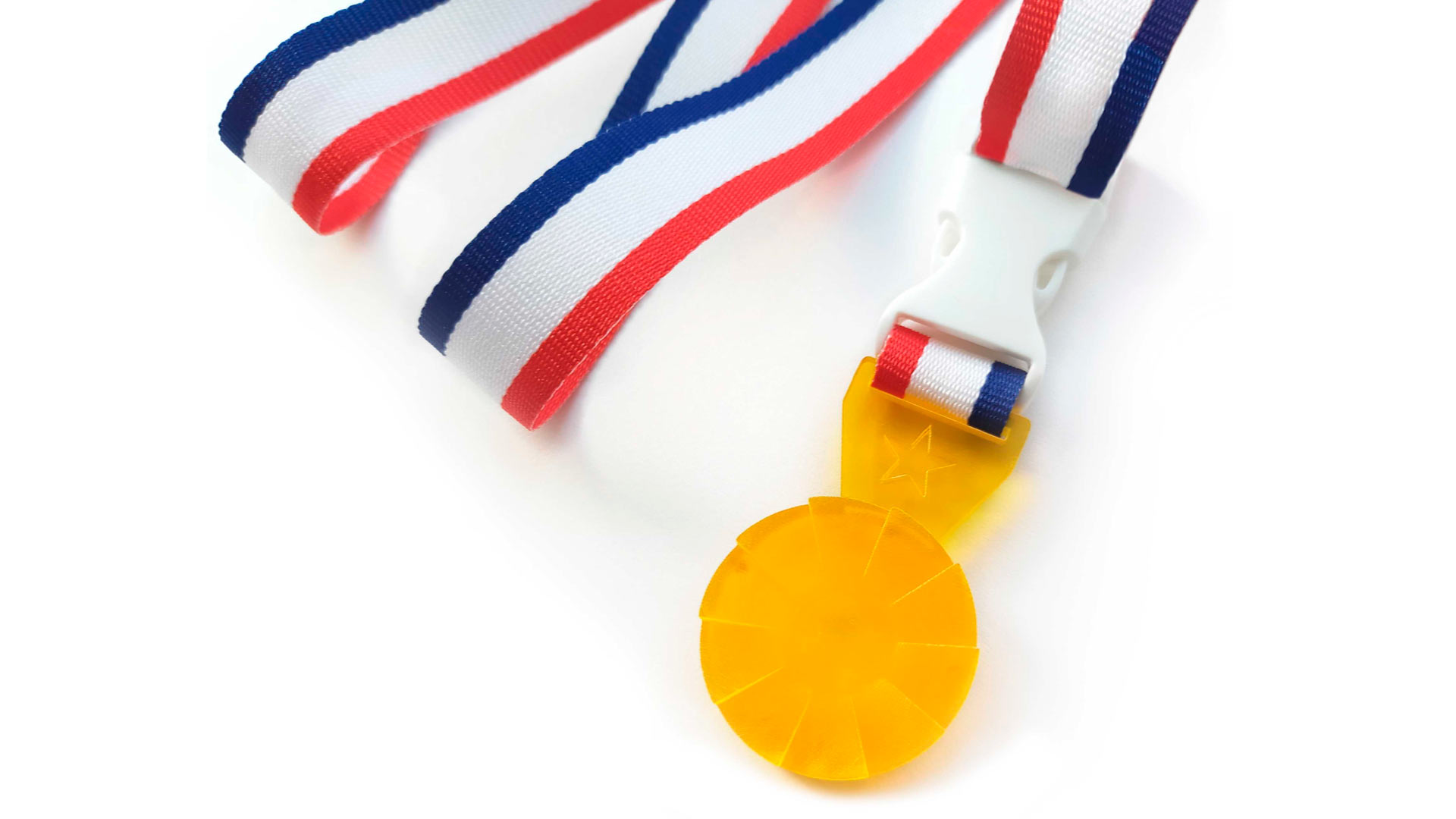
Fountain Medal
Yuki Sugihara / ATELIER OPA, 2021.
If there were a fountain competition in sports, the key points would be the speed of completion, and difficulties Now, let's try our hand at generating "butterflies" and "twists" of flowing water. If you can create a butterfly that forms with a small amount of water (20% water-saving compared to ours) and the world's first twisted water film (patent pending), you are a surface tension medalist.
Luxury fountains are out-of-date. Under the covid-19 pandemic, we need fountains created with small amounts of water and managed hygienically by individuals, rather than fountains that circulate large quantities of water in public places. Each household has its own water infrastructure. Why not enjoy a short water play using tap water in the kitchen or bathroom?
Fountain Medal: Butterfly and the Sun
When you apply the Fountain Medal to tap water, it creates sun-like streams of running water from one side and a butterfly water film from the other. This is the smallest fountain device ever developed by fountain artist Sugihara. It uses 400 ml of water for 10 seconds. Concentrate on the balance of your fingertips for a short time and enjoy the beautiful shapes created by the surface tension of the water.

HOW TO PLAY
While putting on the ribbon around your neck, when you unbuckled it, the medal in your hand to play with water. Find a faucet that produces clear, straight water, and let the water out in a thin stream. In fluid mechanics, the flow of water without dripping is called laminar flow.
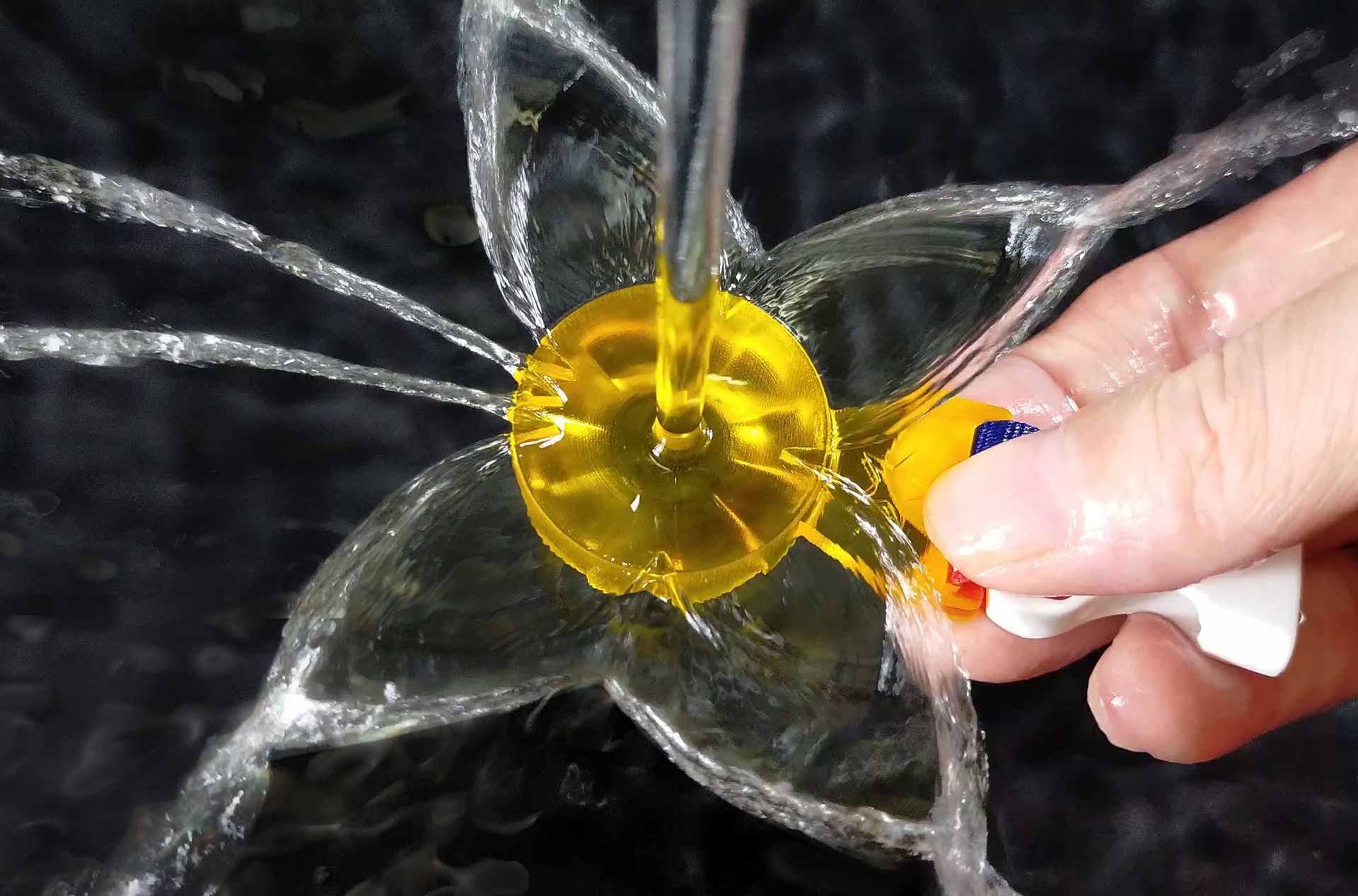
On the Butterfly side, two antennae and V-shaped wings can be formed on the left and right sides of the body.
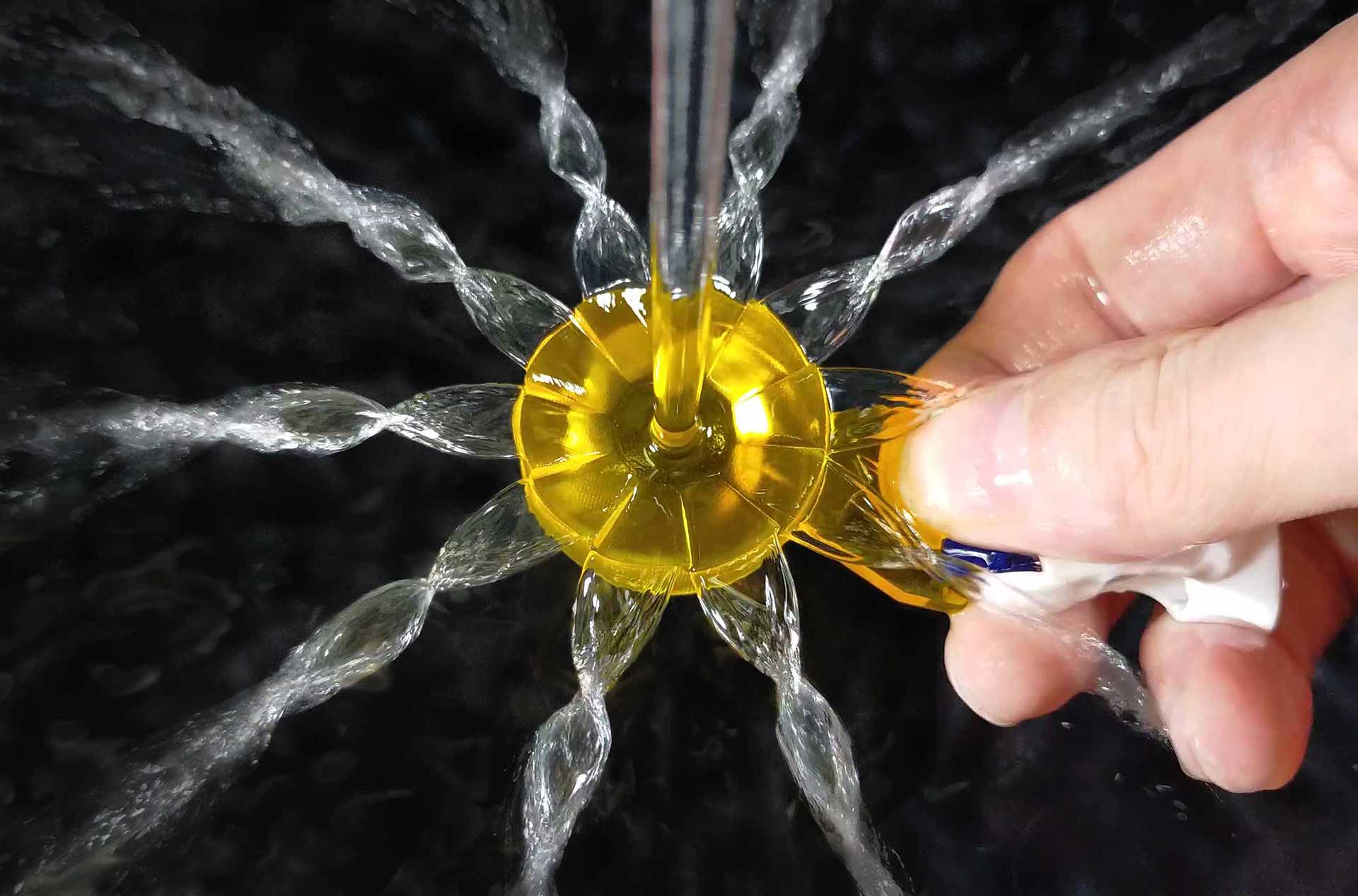
On the Sun side, the running water twists in the middle like glasswork. The degree of twisting varies depending on the position of the falling water.
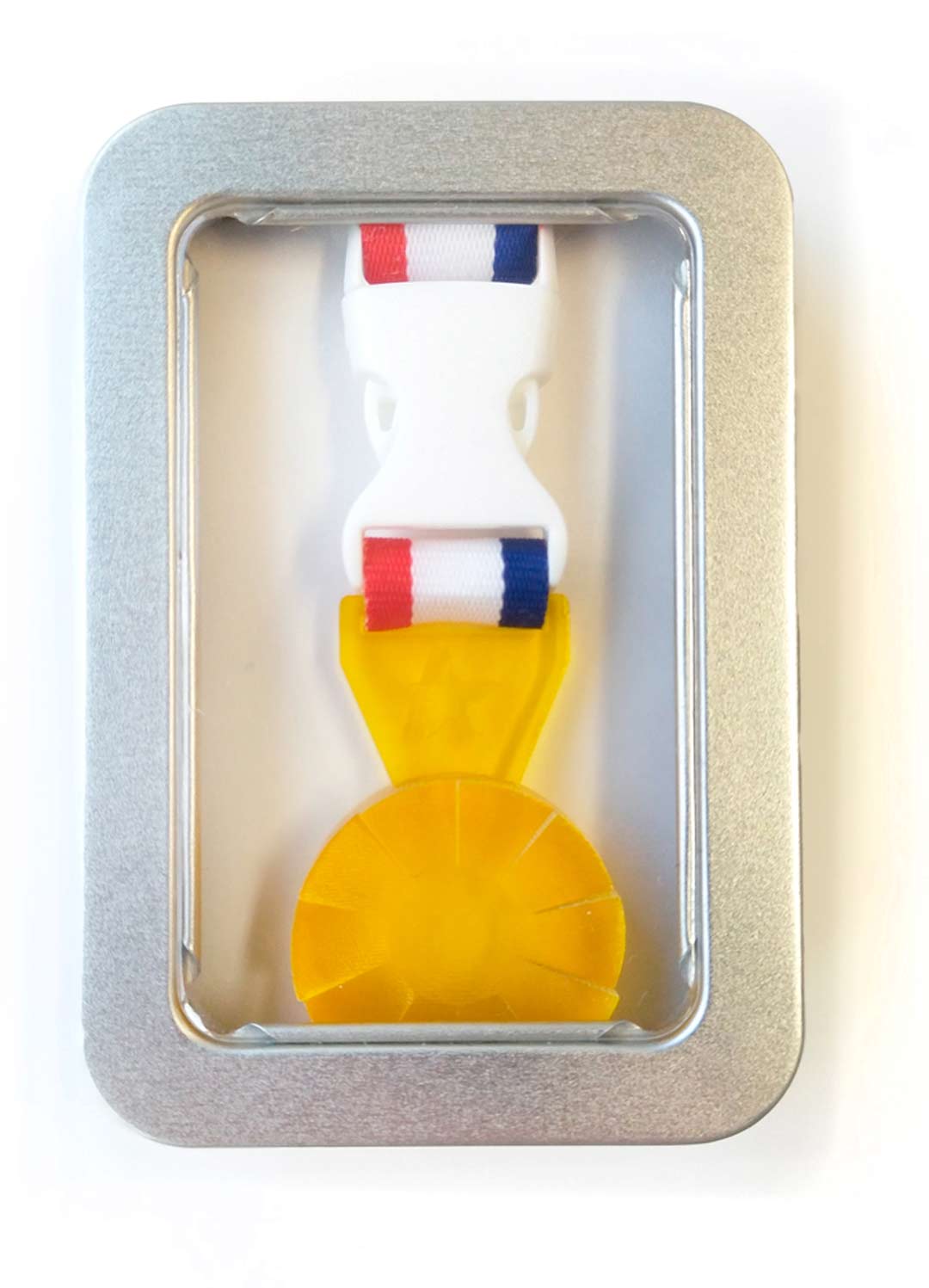
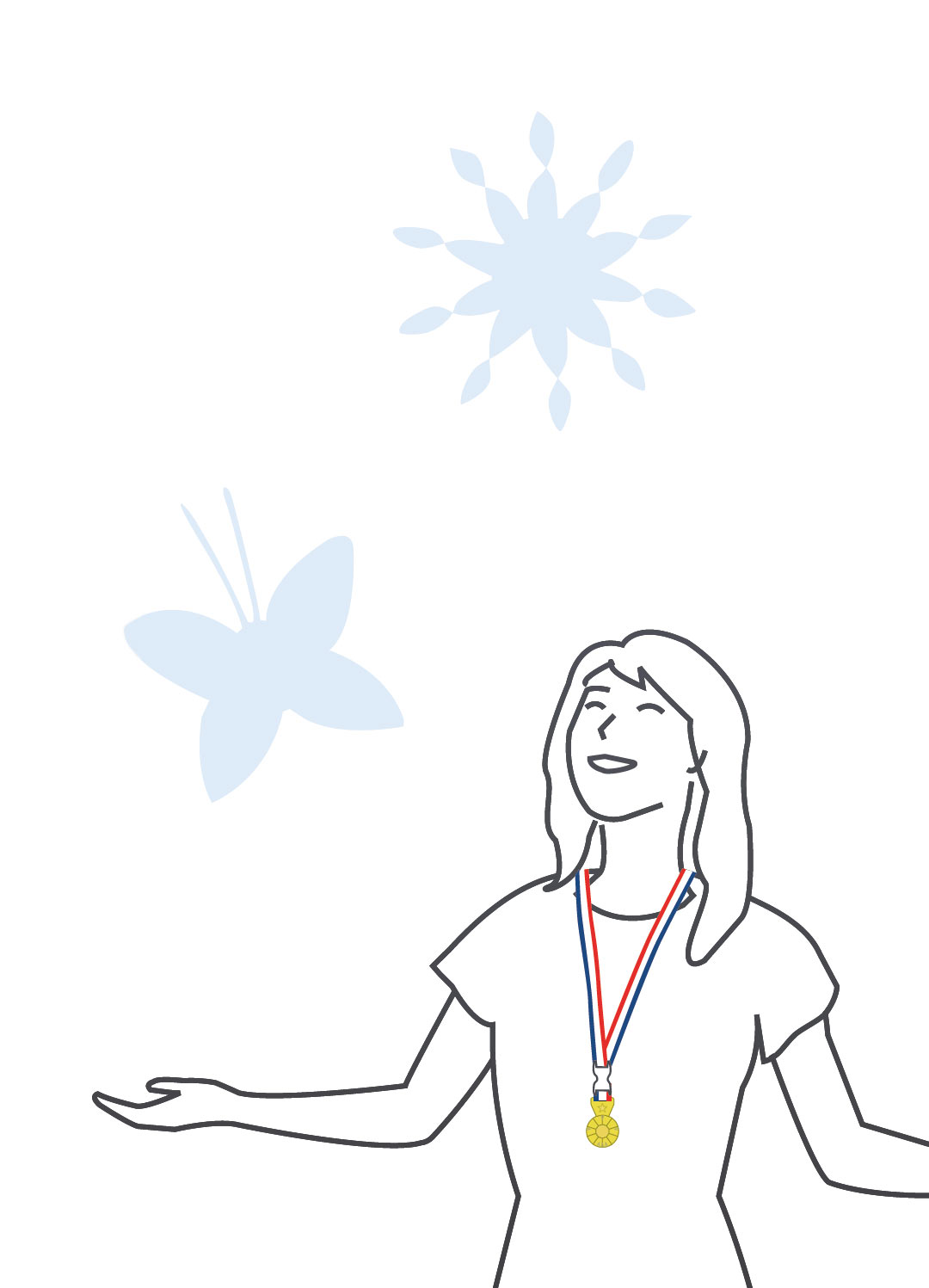
Fountain Medal is a new water play product that considers art, fluid dynamics, and hygiene.
Medal: 3D printed, yellow clear acrylic
Medal size: 2.8 cm x 4.4 cm x 1 cm
Detachable buckle: 1.9 cm x 3.8 cm
Ribbon length: 70 cm x 1.5 cm
Aluminum can package: 9 x 6 x 1.8 cm
Made in 2022
Fountain Medal User Reviews (August 2021 - January 2022)
My kids took a bath with their medals. It was a long bath without washing their bodies. Older brother, a first-year junior high school student, was overjoyed. He made a good sun fountain. We watched the video on this site from the QR code. Later I took their picture after they put on their pajamas.

Thanks for the neat piece! My kids immediately read the instructions and played with it, making the butterfly and the sun. I see that this was made with a 3D printer. It can be mass-produced and sold well. It's lightweight, and it looks like the best combination of a toy feel and an artistic feel. It's going to be a hot topic. It looks simple, but it is very skillful, and I wondered how many prototypes they went through to get to this point.
It was an interesting idea to make it into a medal, wasn't it? The package was also cute.
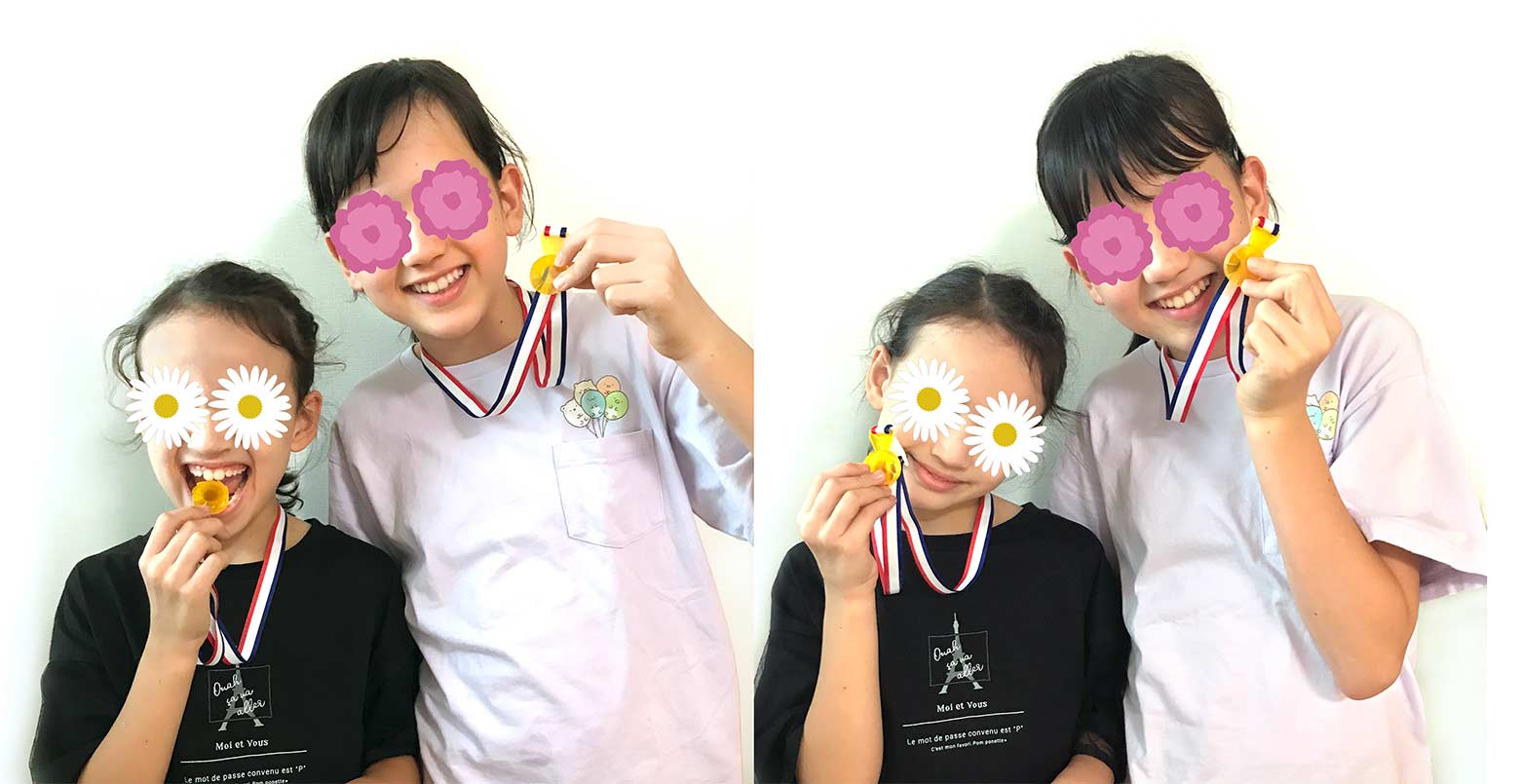
I was amazed at the clean water film. It was interesting that the shape of the sun changed a lot depending on the distance from the faucet. I was fascinated by the area where the joints of the ribbon turned inside out.
When the kids played with the medals in the kitchen, they both said, "Wow! was their first comment. The shapes are clearly visible, so the fun of the game is conveyed clearly. The children said, "It is interesting that the shape of the butterfly and the sun changes depending on the height, strength of the water, and how the water is applied.
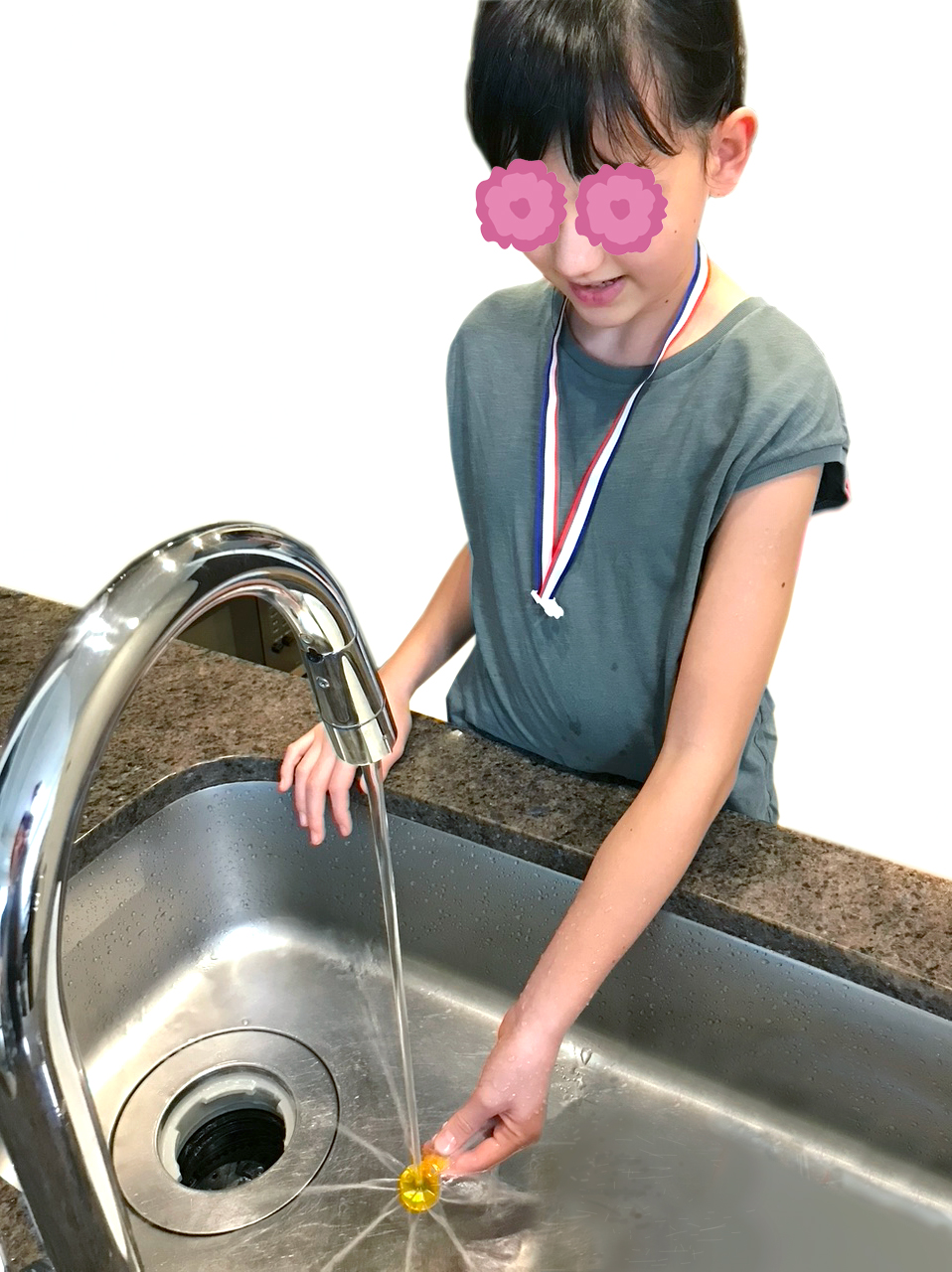
Fountain Medal has arrived! Thanks! My child, 7-years-old-birthday-girl, immediately enjoyed playing with it. I sent her handwritten feedback.
"Dear Ms. Sugihara, Thank you for the Fountain Medal. I enjoyed making the butterfly shape very well. I was able to make the butterfly quickly, but it was difficult to make a beautiful shape for the sun. But after practicing, I was able to do it. I thought it would be fun to play in the bathtub. I also wanted to do water experiments with various other things."
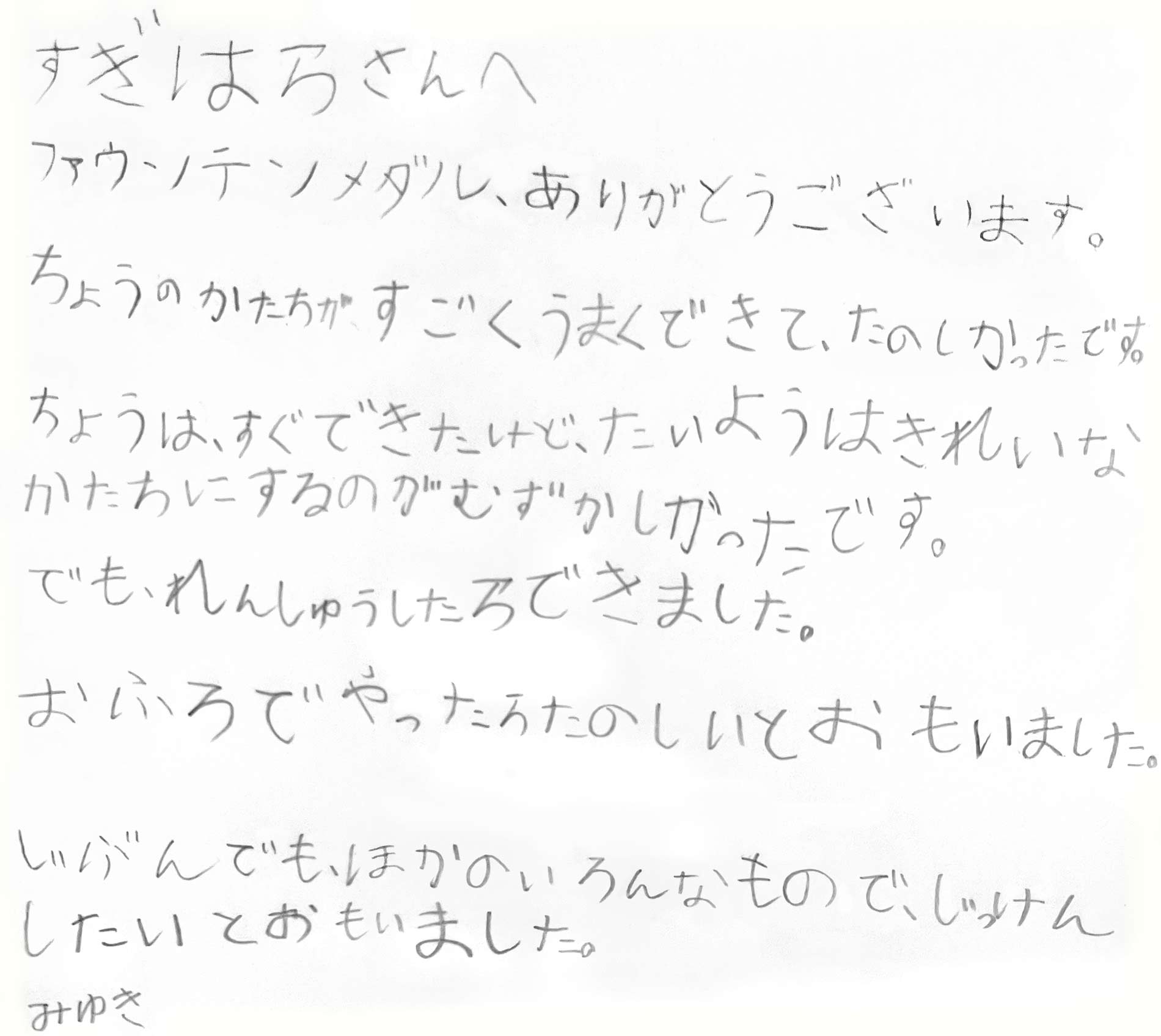
Yuki Sugihara, a pioneer of water membrane art
Yuki Sugihara was fascinated by the heart-shaped water film created from a spoon in 1994, and received her PhD in research and development of fountains at the Tokyo University in 2001.
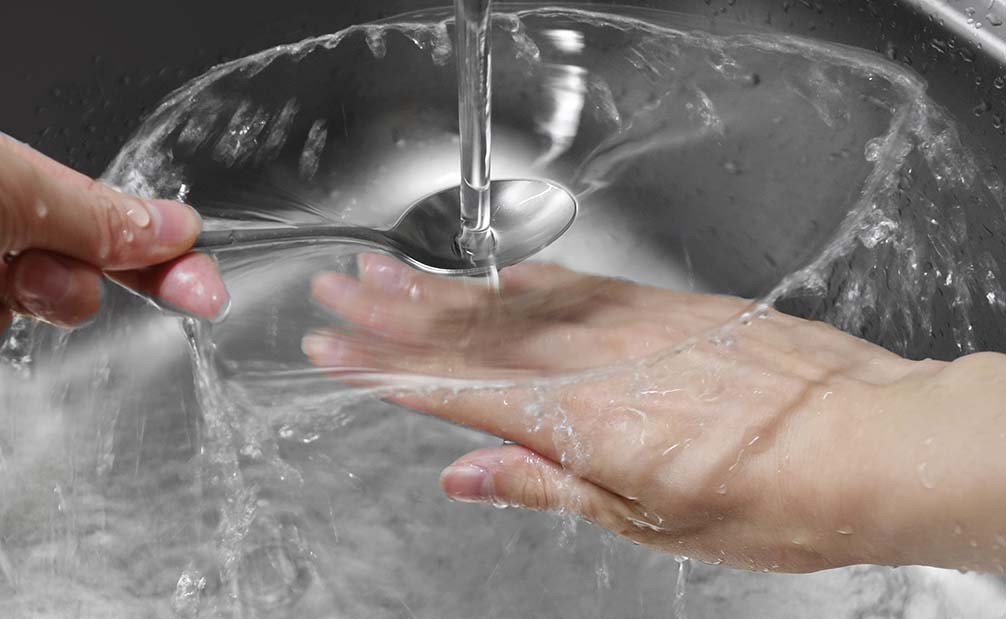 From 1999 to 2009, she developed a large dome-shaped fountain at exhibitions, Expo and outdoor festivals, and then turned to saving water in the wake of the 2011 Great East Japan Earthquake.
From 1999 to 2009, she developed a large dome-shaped fountain at exhibitions, Expo and outdoor festivals, and then turned to saving water in the wake of the 2011 Great East Japan Earthquake.
In 2013, Sugihara won the Lexus Design Award for five types of water membrane made from domestic tap water, saying, "I want to make something small but beautiful."

The "fountain ring" that creates a fountain of butterflies and spiders, launched in August 2015, became a hot topic in the Japanese media. And by 2020, the cherry blossoms, snowflakes and the sun were completed.

In the field of children's science education, there are various movements regarding fountains.
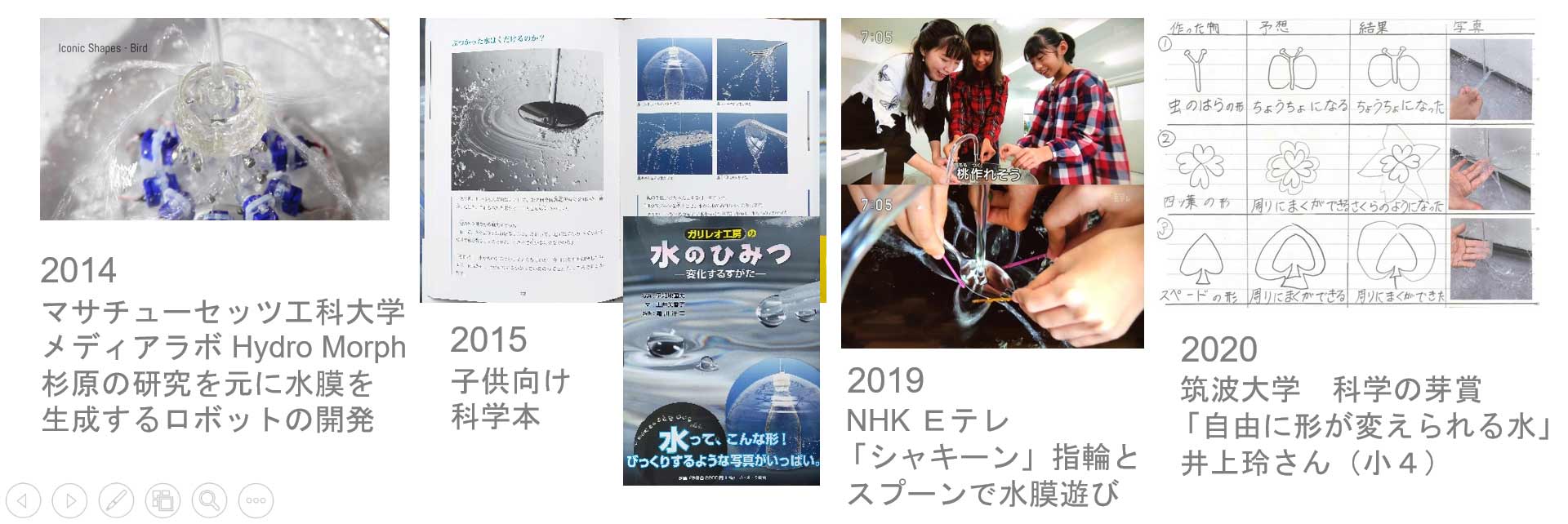
- 2014 Massachusetts Institute of Technology MIT Media Lab refers to Sugihara's research and researches robots that form water films.HydroMorph
- A book, The Secret of Water at Galileo Kobo-The Changing Shape" released in Japan in April 2015 is a bible for elementary school students who are experimenting with water.
- In the summer of 2018, Sugihara started developing fountain medals. VIDEO: Fountain medalist.
- Sugihara appeared on the kids programm on NHK Educational in January 2019. VIDEO:"Shakin":Playing with water using Fountain ring and picks.
- In November 2020, a research of water membranes by the fourth grade of elementary school girl was selected at the science competition sponsored by the University of Tsukuba.
As a result, we can say the Fountain Medal is a toy that creates new value and experience for the needs of stay home edutainment.
The study of the fountain continues.
YouTube
Fountain History and Design
Yuki Sugihara has been fascinated by the water film on spoons and has observed fountains worldwide while creating fountains since 1994. In 2020, she invented a new fountain with a twisted tip of water film. The video "Fountain History and Design" (5 minutes) summarizes her tireless research and the joy of touching the water film.
Video and Text by Yuki Sugihara The Roman aqueduct was completed in 3 BC. Then water places were created in the cities. One faucet was made for drinking, two faucets for fetching water, and four faucets in four directions were made. The faucets of hot springs and a walking path along with the fountain create relaxing spaces. People drink water, wash their hands, purify themselves, and play with water. The falling water represents nature, while the high spouting water represents technology and power. The number of running water represents power, and the curve water represents elegance and technique. Random parabolas show rough quality, while an accurate landing conveys the skill of the design.
Let's think about the design of the fountain. Unique sculptures are not always necessary. the design of fountains is just like a cake. The sculptures are fruits, and the running water is fresh cream. A cylindrical fountain is like a hollow chiffon cake. The overflowing water represents chocolate cake, and the four-layered structure is the same as a wedding cake. The Ballroom fountain at the Palace of Versailles is magnificent. Layered water reminds us of a Baumkuchen or a Mille crêpes.
I was fascinated by the water membrane created by the spoon in 1994. My hand didn't get wet beneath the water. In 1996, I designed the Head-Mounted Water Display with a diameter of 70 cm. It was a fantastic experience surrounded by water. The maximum size of the water membrane was 1.8 meters. In 2002, I made a water cocoon that accommodates several people. When you looked up at the ceiling, there was a transparent world. In the water dome of 8m, the water membrane transformed to droplets, becoming a screen for projection mapping. I installed temporary water domes 11 times, indoors and outdoors in Japan.
Since 2015, I have been making fountain rings. I traveled with this mobile fountain. In the exhibition in Venice, the visitors experienced and took photos. At the bathroom in Milan, a boy played with the ring. He said he likes it very much. At the kitchen in the USA, a girl smiled and showed me her butterfly. At the drinking water in Stuttgart, Germany, I made the spider with running water, and in the Bauhaus, I made the butterfly using a watering can. Wherever there is a faucet, fountain rings can demonstrate the wonder of water.
The spider's ring shows Eight legs in a classic arc. The butterfly ring shows transparent wings and straight antennae. The cherry blossom ring shows five petals. V-shaped hollow in the edge is the highlight that I took two years to develop the subtle design. In 2019, I developed the snowflake ring. Stellar plate shape makes 12 arms. This year, I studied propeller steps with a small amount of water. With four wings, running water intersects at the tip. With six wings, the tips were rotated 90 degrees. With 8wings, the tip is more twisted. With ten wings, the twists are like glasswork. Let's see the fountain and flower collection in 2020. In addition to the Snow ring, I created the Sun ring for this exhibition.
I love fountains in the cities, but I also love small fountains. Let’s update our knowledge of water design together.
■DX of Fountain
CFD(Computational Fluid Dynamics)reveals the phenomenon.


Yuki Sugihara
Fountain Works
Profile (in Japanese)
© ATELIER OPA Co., Ltd. All rights reserved.